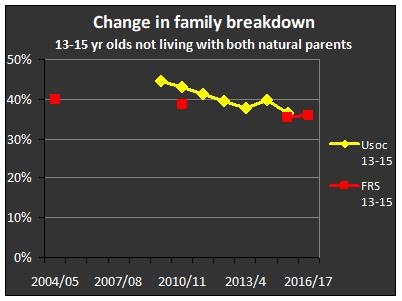One of the issues we’ve tried to address at Marriage Foundation is to find out the scale of family breakdown.
A few years back, we addressed this by analysing data from 2010 in a big national survey called Understanding Society. From this, we worked out that 45 per cent of all teens were not living with both natural parents. I still think this is one of the most shocking statistics we’ve produced.
We’ve tended to assume that this figure would keep getting worse until society addressed the trend away from relatively stable marriage and toward relatively unstable cohabitation. The argument was that as more and more couples embraced cohabitation rather than marriage, more and more couples would split up.
But even though fewer couples marry, those who do marry have been doing better and better. Divorce rates in the early years of marriage have been falling steadily over the past twenty years or so.
So which is the dominant force? Is family breakdown continuing to increase as fewer couples marry? Or is the lower divorce rate leading to less family breakdown overall?
Along with my colleague Professor Steve McKay at University of Lincoln, we looked at the proportion of children of all ages not living with both natural parents and how this has changed over time.
You can read the report here.
Understanding Society (USoc) – the survey we originally used – now has data following much the same set of families through to 2016. So as well as 2010, which we already knew about, we could see what the situation was for families in 2011, 2012, through to 2016.
Our finding was a big surprise.
Looking at children aged from 13 to 15 – combining three years so that we get a bigger sample – the trend was clear. Whereas 44 per cent of kids were not living with both natural parents in 2010, this proportion had fallen to 36 per cent by 2016.
This seemed like a really big fall. So we double checked by looking at similar data from another survey called Family Resources Survey (FRS). This survey doesn’t follow the same group of families year after year but looks at a fresh set. It’s possible this might give more reliable data because we don’t have to worry about attrition – ie the people who don’t respond next time round are more likely to be those who are struggling.
What we found here was that 40 per cent of children were not living with both natural parents back in 2005. We then looked at the survey results for 2011, 2016 and 2017 and saw a similarly clear downtrend. In the latest survey, the figure had dropped to 36 per cent – the same as we found in USoc.
One of the other things we looked at in FRS was the marital status of the parents who were still living together by the time their child was aged 13 to 15. Back in 2005, this was 96 per cent of all parents. In the latest figures, it was 90 per cent – lower but still the vast majority.
What this shows pretty strongly is that what happens to married parents is going to influence the overall level of family breakdown far more than what happens to unmarried parents. Perhaps we should have realised this earlier. Anyway, we know it now.
As a cross-check, using data from the Office for National Statistics, I also looked at what has happened to divorce rates during the first fifteen years of marriage. Divorce rates are down by 11 per cent from their peak and will probably fall by as much as 28 per cent. So those couples who have only been married five or ten years right now will almost certainly have even lower divorce rates than those who have just completed their first fifteen years.
Alas the one question we really can’t answer at the moment, because the data is just too difficult to analyse, is what is happening to unmarried parents. Are they doing better or worse?
In some ways, this is a secondary question. Because what happens to married parents is what has by far the biggest impact.
So our new findings are the first really clear evidence that falling divorce rates have had a direct and measurable impact on the overall level of family breakdown.
That’s only part of the good news.
This has happened without any input whatsoever from the government on supporting marriage. The small scale marriage tax allowance was introduced too recently to have made the difference we are seeing. And in any case the amounts are relatively trivial and poorly focused.
So imagine what could happen if government did get involved and start supporting marriage and commitment – with clear signals about the importance of marriage and financial incentives to marry.
Whether they ever do or not, the really good news is that family breakdown is likely to fall even further over the next decade whatever happens.
As married couples do better, this is good news for couples, good news for children, good news for society, and good news for 2019.
Happy new year!

